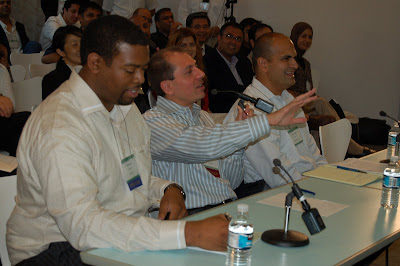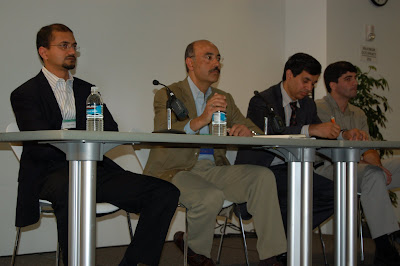
California Professionals Helping Kashmiris build their homes
Heavenly valleys of Kashmir seem to be cursed. If ongoing violence in that region was not enough to dampen the spirit of the locals, the area was hit by a powerful earthquake in 2005. Although Kashmir sits on the edge of a tectonic plate being constantly pushed by another, no noticeable seismic activity was recorded for decades and no one was ready for a strong shake of houses and other buildings. The October 2005 earthquake killed more than 79,000 people, many were crushed under crumbling buildings. Global-villagers from all over the world rushed to help. Martin Hammer and Shannon Whitnack of California who last Saturday gave a talk on ‘Straw-bale homes’ also reached the devastated areas and helped locals in building homes. Since things were starting anew the two Californians saw an opportunity to introduce their favorite technology, of straw-bale construction.
It makes perfect sense to make houses using material readily available in the area. Why make a marble house in the woods? In agricultural societies building material should be looked for in crops, and hence the choice of a straw-bale home. Strictly speaking straw-bale house is a misnomer because straw-bales are only used in constructing walls: foundation, floor, and roof have to be made with other material.
It is hard to make walls of straw if you don’t have means to keep the straws together. And that is the reason straw-bale houses truly came into existence after technologies to compact straw in the form of bales were developed.
Speaking to a small audience Martin Hammer described his experiences in helping Kashmiris build straw-bale homes. Hammer and Whitnack had brought with them a straw-bale, a 1 ft by 1 ft by 2 ft “building block” of compacted straw weighing around 6 lbs. The straw used in that bale was that of rice. Though straw obtained from other crops can also be used Hammer and Whitnack appear to be most satisfied with the performance of rice straw. The reason could be that rice straw is of the right thickness and height. For, if stems of a crop are too thick they would not intertwine together for a good bond. And if the stems are too small in height it would be hard to hold them together in shape of a bale. A simple back of the envelope calculation—with the assumptions of 95% compaction, 3 ft high 1/8” dia stalks, plants grown 3 inches apart--indicates that an acre of paddy field can yield enough straw to make seven bales of the above dimensions.
One can imagine the shortcomings of straw-bale construction. That you can only make a single-story building, that you cannot build very high walls, that you must use plaster to protect straw–bales from excessive moisture. Contrary to intuition, straw-bales are reasonably fire-resistant. Once compacted the inside of straw-bale does not have sufficient oxygen to keep the oxidation process going.
Shannon Whitnack described to the audience the shock-absorbing capacity of straw-bale walls, the second strong reason for making straw-bale homes in regions of high seismic activity—the first being the low construction cost. Whitnack also emphasized the point that moisture easily passes through straw-bale walls without being absorbed by the straws.
Along with their Pakistani counterparts Martin Hammer, Shannon Whitnack and other building professionals from California have formed a group they call Pakistan Straw Bale and Appropriate Building. Readers interested in helping this group build low cost houses in Pakistan can make contact through group’s web site at http://paksbab.org/
Labels: کشمیر، پاکستان، زلزلہ، گھاس گٹھر، گھر، عمارت سازی، مارٹن ہیمر، شینن وہٹنیک، اسٹرا بیل































